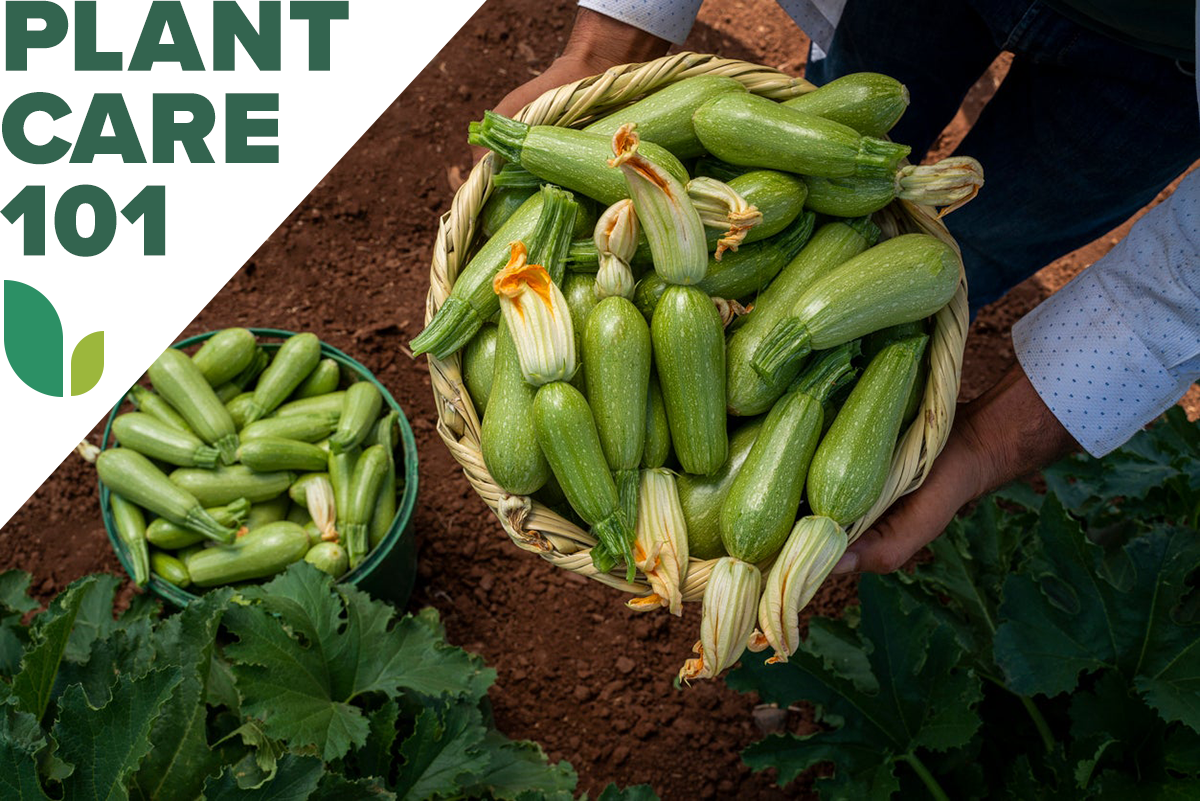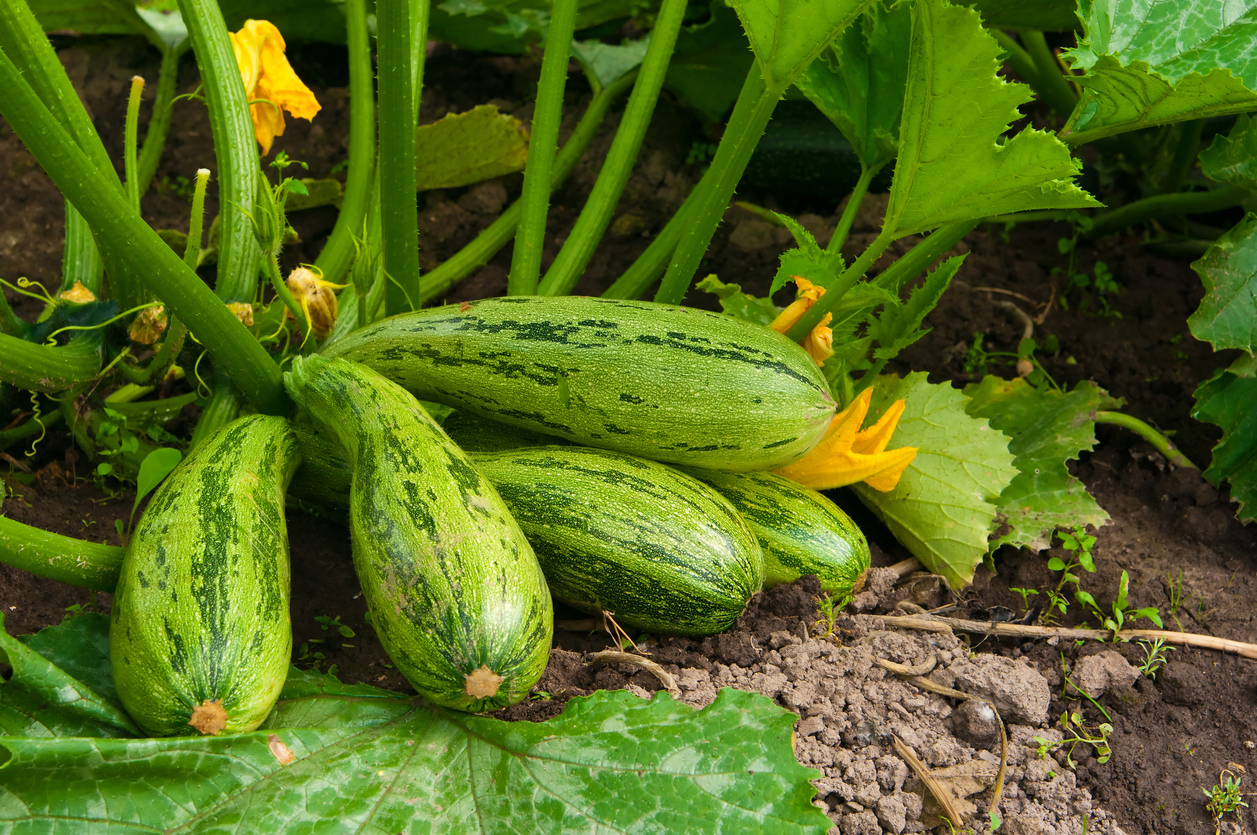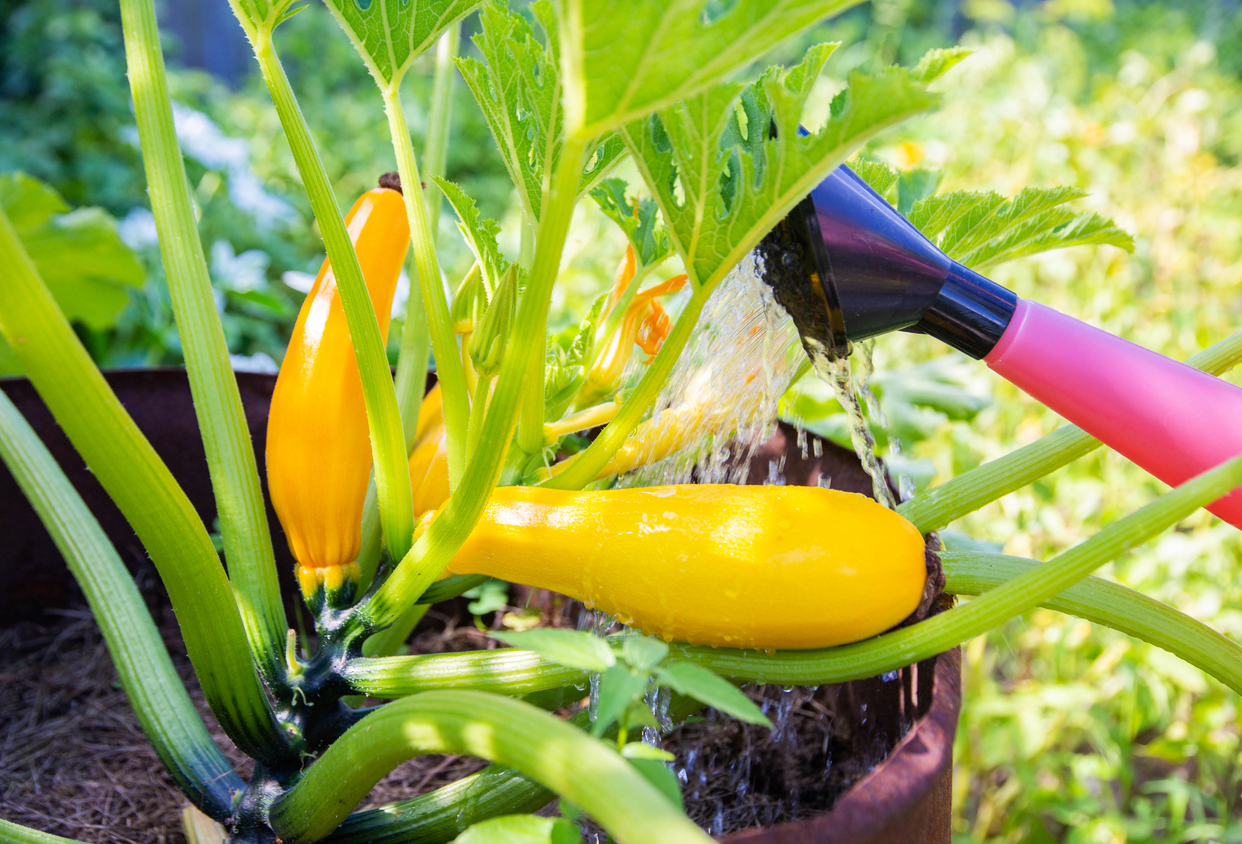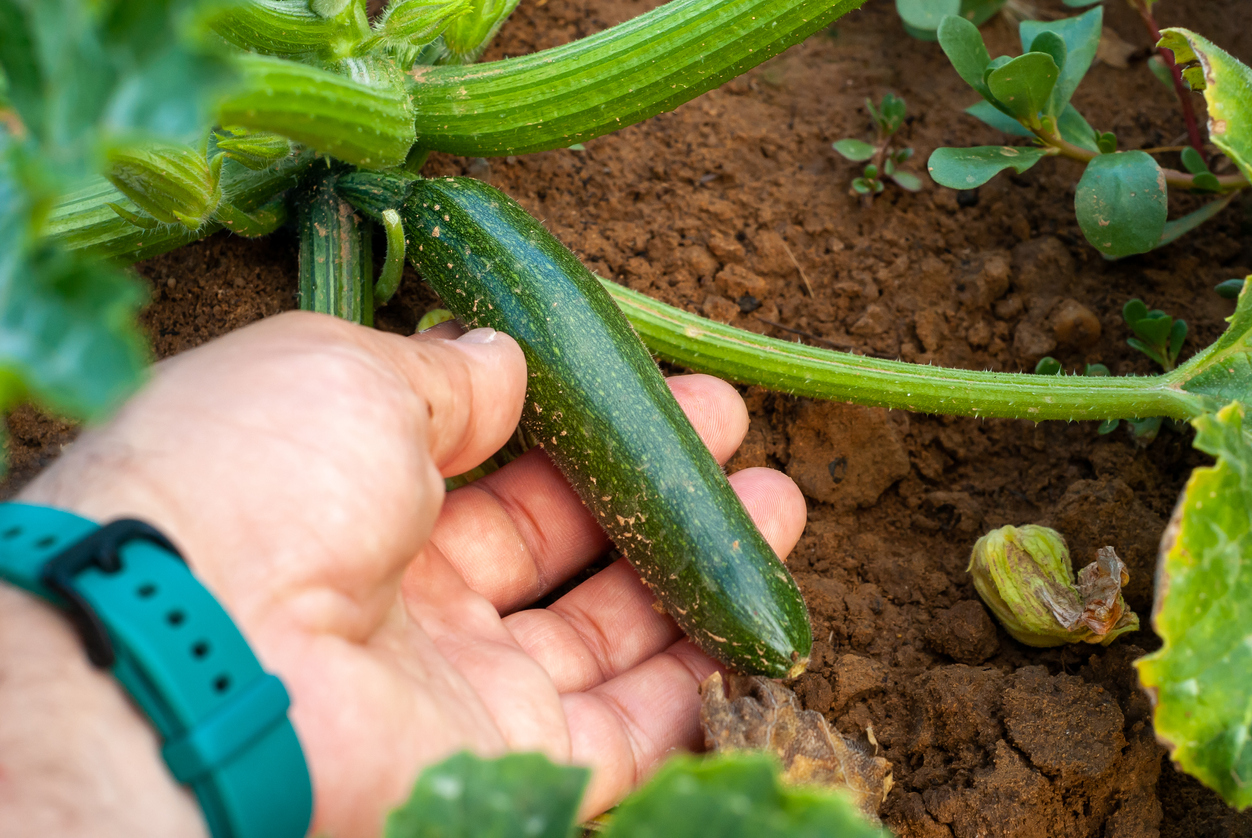

We may earn revenue from the products available on this page and participate in affiliate programs. Learn More ›
As all the old jokes about country people not locking their doors except during zucchini season imply, growing squash can be a little too easy. And while figuring out what to do with the overabundance might become a problem, it is a good problem to have.
When learning how to grow squash, keep in mind that—unlike winter squash—summer squash are harvested at an immature stage before their rinds harden. Therefore, these fast-growing vegetables can make a crop within 50 days or so.
Growing Squash at a Glance
Common Name: Summer squash, zucchini, yellow crookneck squash, pattypan
Scientific Name: Cucurbita pepo
Hardiness Zone: Annual
Soil: Fertile, moist but well draining
Light: Full sun
Water: High
Food: Organic vegetable fertilizer
Propagation: Seeds
Safety: Edible fruits and blossoms
Squash Characteristics
Native to Mexico and the southern United States, a summer squash plant typically assumes a bush-like shape, while the winter variety tends to make sprawling vines. However, all types of squash have lobed leaves and yellow flowers, with both male and female blooms produced on the same plant. The male blooms appear at the end of thin stalks while the smaller female ones hunker closer to the vine on shorter, thicker stems with what looks like a miniature squash beneath each one.
After a flower is pollinated, that miniature fruit will begin to grow into a full-size one. Varieties for summer squash gardening include the cylindrical green type, also known as zucchini or Italian squash; the scalloped and white, yellow, or green UFO-shaped variety, also referred to as pattypan squash; and the narrow-necked yellow type that’s often simply called crookneck, summer squash, or yellow squash plant.
RELATED: How to Grow a Three Sisters Garden at Home
Recommended Squash Varieties

- Jaune et Verte: This open-pollinated pale-green pattypan squash matures in 50 days, while fruits too aged for eating turn white striped with green and might be used for autumn decorations.
- Raven: The dark-green lutein-rich fruits on this hybrid zucchini mature in just 48 days.
- Yellow crookneck: A traditional open-pollinated type of yellow summer squash, crookneck is aptly named for its bent neck; it matures in 58 days.
- Zephyr: This decorative hybrid summer squash produces yellow fruits with green blossom ends and matures in 54 days. Its parentage includes yellow crookneck squash and an acorn and delicata cross winter squash.
Planting Squash
If you prefer to start your seeds indoors, sow them in 2- to 3-inch pots about 3 to 4 weeks before you intend to set them out.
When is the best time to plant squash?
Usually sown directly into the vegetable garden, summer squash seeds require warm conditions to sprout. Wait to plant them, therefore, until a couple of weeks after the last spring frost or whenever the soil is 70 degrees Fahrenheit a couple inches below the surface and at least 60 degrees 4 inches down.
Where can squash grow?
Choose a location in full sun with fertile, moist, well-draining soil, preferably with a pH between 6 and 6.5. To lower the chances of their contracting diseases or overwintered garden pests, avoid planting squash where other cucurbits—such as melons, cucumbers, and other squash—have grown within the past 3 years.
How do you plant squash?
You can sow squash either in rows or hills.
- Sow the seeds ½ inch deep and 4 to 6 inches apart in rows 3 feet apart.
- For better squash spacing, once the seedlings sprout in 5 to 10 days, thin them to stand 1 to 2 feet apart.
- If you prefer to sow on hills for better drainage, construct mounds at least 3 inches tall and 18 inches wide—which stand 3 feet apart—planting four seeds 1 inch apart (an an inch deep) in the center of each hill.
- Once the seeds sprout, snip off the weakest squash seedlings on each hill, leaving only one or two of the strongest.
- Refrain from adding mulch around the plants until the soil temperature has reached 75 degrees.
Can you grow squash in containers?
Although the sprawling size of winter squash often places them among the vegetables not to plant in containers, summer squash is somewhat more compact. According to Oregon State University, yellow squash cultivars such as ‘Fancycrook’ and ‘Goldbar,’ along with ‘Raven’ zucchini and ‘Sunburst’ pattypan can be grown in large containers such as half barrels. Make sure that each plant will have a foot of soil on all sides.
RELATED: 11 Plants You Should Never Start Indoors
Watering Squash Plants

As with most vegetables, squash will require at least 1 inch of water per week from rain or irrigation, possibly up to 1½ inches in sandy soils. If possible, choose drip rather than overhead irrigation, and water the plants in the morning to allow them to dry off before nightfall; these steps help avoid fungal diseases. Some gardeners prefer to plant squash inside holes cut in a polyurethane mulch that warms the soil and can help keep the ground more evenly moist. However, plastic mulch might cause the soil to retain too much moisture in wet climates.
Fertilizing Squash
Work compost into the ground several weeks before planting your squash, applying it at the rate of about 1 pound per 5 square feet. Also apply an organic vegetable fertilizer such as 3-4-4, using 3 pounds per 50 square feet and mixing it into the upper 4 to 5 inches of your soil. When considering fertilizer for squash, keep in mind Clemson University’s warning: “Do not overfertilize with nitrogen because this encourages excess vine growth and reduces fruit growth.”
Pollination
Don’t be alarmed if the first blossoms on summer squash plants wither and set no fruits. That is typical of squash, since the male blooms tend to open first and may have no females available to fertilize.
However, if the lack of fruit set continues, you can handle the pollination yourself. In the morning, shortly after the blooms have opened, pick a male flower and press pollen from its stamen onto the stigmas of the female blooms that are open at the same time. You may want to remove the male’s petals first to make the “painting with pollen” easier.
Safety Considerations
Most squash fruits and squash blossoms are safe to eat. However, it’s best to pick only male blossoms to leave more of the females for fruit set. Also, avoid consuming any squash that tastes extremely bitter, since a high level of cucurbitacins in them—sometimes caused by poor environmental conditions—might cause nausea and/or diarrhea.
Because squash plants can be prickly, wear gloves when weeding around them or harvesting fruits from the vines. That should help prevent the bristles from irritating your skin.
Potential Pests and Diseases
Squash vine borers, the larvae of clear-winged moths, tunnel into the stems of the plants. Meanwhile, brownish-black squash bugs suck the life from the leaves. To kill such overwintering pests, it’s a good idea to till your garden—if possible—in late winter rather than spring.
Gardeners in southern climates also may be able to get ahead of such borers and bugs by planting their squashes well before the pests appear in early summer. Squash bugs like to hide, so you can lay down cardboard or boards beside the plants in your garden and turn those covers over later to expose—and squash—the insects.
Harvesting Squash
About 50 days after you planted your squash, begin checking them for fruits.

When is the best time to harvest squash?
Harvest yellow summer squash and zucchinis when they measure about 1½ to 2 inches in diameter and 7 to 8 inches long. Their skin should still be glossy at that point rather than exhibiting the matte look they take on later. Pick pattypan squashes when they measure 3 to 4 inches across.
How do you harvest squash?
Avoid picking squash when the plant’s foliage is wet, since that can spread disease among the plants.
- Use pruning shears to snip the stem about 1 inch above the squash you wish to harvest.
- Lay it gently in a basket or bucket to avoid cutting or bruising its skin.
- Also remove and discard any squash that are too large and old to use, since they can inhibit the plants from producing more tender young ones.
How do you store squash?
Store squash unwashed in the crisper drawer of the refrigerator until you intend to use them. It’s best to eat them within 4 days or so after their picking, though some may last up to a week or more. Only wash them just before you intend to cook them, as extra moisture can reduce their shelf life.
Looking for more fast-growing vegetables? Check out our guides on growing cucumbers, green beans, and kale.
